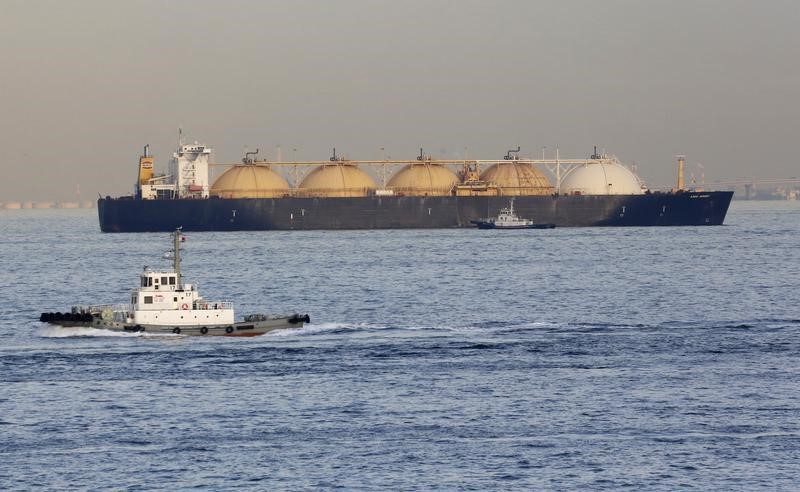(Repeats with no changes to text)
By Clyde Russell
LAUNCESTON, Australia, Nov 21 (Reuters) - Sometimes the seemingly illogical actually makes sense. Take the case of Australia, which will become the world's largest exporter of liquefied natural gas (LNG), but also may start importing the super-chilled fuel at the same time.
Australia is in the final stages of completing more than $180 billion of LNG projects that will see it overtake Qatar as the world's largest supplier by the end of next year.
When the last of eight new facilities is finished, Australia will have 10 operating projects capable of producing about 85 million tonnes of LNG a year.
Given the huge surge in LNG production in Australia, it would seem extraordinary that it would have to import the fuel to meet domestic requirements, but that is exactly what major domestic utility AGL Energy AGL.AX is considering.
The company said on Nov. 14 it would spend A$17 million ($12.8 million) on a feasibility study for an import terminal in the southeast of the country, home to most of the nation's gas-consuming industries and the largest retail market. AGL has identified is Australia is facing a set of circumstances where economic realities are colliding with geography and politics.
Firstly, the economic realities. The building of three new LNG plants in Queensland state, on the country's northeast coast, has dramatically altered the supply-demand balance along the populous eastern seaboard.
The three LNG plants use coal-seam gas as feedstock, but they are also capable of tapping into the existing pipeline network that draws natural gas from fields in central Australia, Queensland and from the offshore Bass Strait between Victoria and the island state of Tasmania.
These three facilities will account for about 70 percent of east coast natural gas demand by 2018, according to AGL.
This means a massive exploration and production effort is required to boost output by enough to meet the demand of the LNG plants.
It also means that pricing in the domestic market will become more tied to international LNG prices on a netback basis, which is the cost of the LNG to customers in Asia minus freight, liquefaction and other costs.
In reality, this makes it likely that the three LNG plants will suck up natural gas that would otherwise have been available to the domestic markets, creating a potential shortage sometime around 2019.
Secondly, the geography part. Although Australia is the world's smallest continent, it's still a huge country and the currently producing natural gas fields in its centre are thousands of kilometres (miles) from where the fuel is consumed in coastal cities.
This means pipelines are needed to transport natural gas, and these dramatically add to the final cost to customers.
It's also far from certain that pipeline investors would be prepared to commit the massive amounts of capital needed to expand the network unless they are guaranteed high rates of return, meaning domestic prices would have to be well above current Asian LNG prices.
POLITICS KEY FOR LNG IMPORTS
Lastly, the influence of politics. The best solution for easing southeastern Australia's looming shortage of natural gas would be to boost onshore production in Victoria and New South Wales, the two most populous states.
However, politicians in both have effectively banned or placed moratoriums on much of the exploration and production sector.
This mainly has been done to appease public opinion, which has increasingly swung behind a coalition of rural interests and environmentalists that oppose both producing natural gas from hydraulic fracturing and from coal-seams.
For farmers, much of their opposition is because of interruptions to their operations from the presence of drilling rigs and associated infrastructure on their land, as well as to fears of pollution of water tables.
While a series of independent scientific reports have stated there is little reason to fear contamination or other adverse effects from natural gas wells, these have been largely drowned out by activists opposed to fossil fuels.
Politicians from both the centre-right Liberal Party, which rules in New South Wales, and the centre-left Labor Party, which controls Victoria, have found it easier to appease these groups than to make the case as to why exploration should go ahead, and the consequences of higher prices if it doesn't.
Enter AGL with a possible solution of building an LNG import terminal in the world's biggest LNG exporter.
It would solve the problem of a potential shortage of natural gas in southeastern Australia, introduce competition with existing players, keep prices to at least the level of what Asian buyers are prepared to pay and allow the politicians to keep appeasing noisy pressure groups.
Overall, the seemingly illogical actually makes perfect sense.
(Editing by Joseph Radford)
